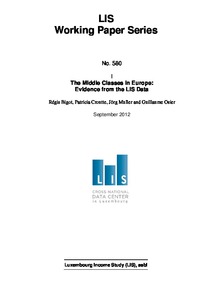The middle classes in Europe: evidence from the LIS data
"The paper draws on the LIS data to describe the socio-economic situation of the Middle Classes for a selection of European countries over the last 30 years. The LIS data were used as they cover a wide range of countries, including not only European countries, but also American and Asiatic coun...
| Main Authors: | , , , |
|---|---|
| Institution: | ETUI-European Trade Union Institute |
| Format: | TEXT |
| Language: | English |
| Published: |
Luxembourg
2012
LIS |
| Subjects: | |
| Online Access: | https://www.labourline.org/KENTIKA-19131594124919597769-The-middle-classes-in-europe-e.htm |
| _version_ | 1771659895601364992 |
|---|---|
| author | Bigot, Régis Croutte, Patricia Muller, Jörg Osier, Guillaume |
| author_facet | Bigot, Régis Croutte, Patricia Muller, Jörg Osier, Guillaume |
| collection | Library items |
| description | "The paper draws on the LIS data to describe the socio-economic situation of the Middle Classes for a selection of European countries over the last 30 years. The LIS data were used as they cover a wide range of countries, including not only European countries, but also American and Asiatic countries like India, China, Russia, Brazil, Peru or Chile. In addition, for some countries, LIS time series start in the seventies, which is particularly interesting for analysis over time. The paper starts with an historical and sociological review of the middle class concept in France, Germany, Belgium and the United Kingdom. Different options are considered then to define the middle classes, namely using subjective (self-assessment) or more objective criteria like income level, education attainment or type of occupation. The income-based definition is finally chosen as comparative data on income are now available in the European countries from sources like the LIS or EU Statistics on Income and Living Conditions (EU-SILC). Besides, income is generally correlated with socio-economic characteristics like age, education attainment or occupation. Based on this definition, summary statistics (size, mean income…) are produced for the middle class households in European countries. We observe that the situation of middle class households varies from one country to another: the group is getting smaller in some countries, while getting larger in others. With regard to income levels, the mean income of middle class households has been increasing over the last decades. However, it should be noted that the increase was in some key European countries (such as France) slower than the increase for lower class or upper class households." |
| format | TEXT |
| geographic | Europe |
| id | 19131594124919597769_786ba0c5c1024262be158df196367a16 |
| institution | ETUI-European Trade Union Institute |
| is_hierarchy_id | 19131594124919597769_786ba0c5c1024262be158df196367a16 |
| is_hierarchy_title | The middle classes in Europe: evidence from the LIS data |
| language | English |
| physical | 1 v. Digital |
| publishDate | 2012 |
| publisher | Luxembourg LIS |
| spellingShingle | Bigot, Régis Croutte, Patricia Muller, Jörg Osier, Guillaume economic and social development income middle class The middle classes in Europe: evidence from the LIS data |
| thumbnail | https://www.labourline.org/Image_prev.jpg?Archive=111307993958 |
| title | The middle classes in Europe: evidence from the LIS data |
| topic | economic and social development income middle class |
| url | https://www.labourline.org/KENTIKA-19131594124919597769-The-middle-classes-in-europe-e.htm |

